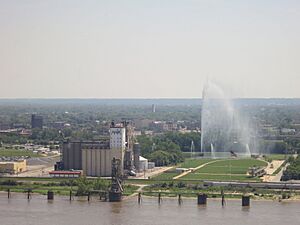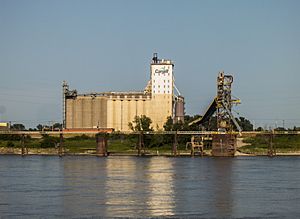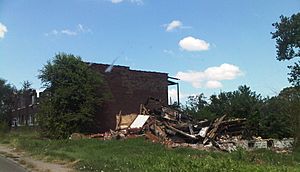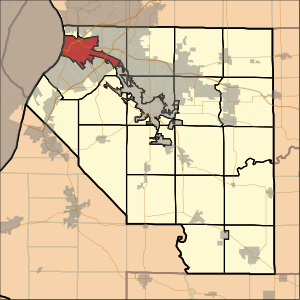East St. Louis, Illinois facts for kids
Quick facts for kids
East St. Louis, Illinois
|
|||
|---|---|---|---|

East St. Louis and the Gateway Geyser
|
|||
|
|||

Location of East St. Louis in St. Clair County, Illinois
|
|||
| Country | |||
| State | |||
| County | St. Clair | ||
| Township | East St. Louis (coterminous) | ||
| Founded | June 6, 1820 | ||
| Incorporated | February 16, 1865 | ||
| Government | |||
| • Type | Council–manager | ||
| Area | |||
| • Total | 14.30 sq mi (37.03 km2) | ||
| • Land | 13.92 sq mi (36.05 km2) | ||
| • Water | 0.38 sq mi (0.98 km2) | ||
| Elevation | 423 ft (129 m) | ||
| Population
(2020)
|
|||
| • Total | 18,469 | ||
| • Estimate
(2023)
|
17,642 |
||
| • Density | 1,326.89/sq mi (512.33/km2) | ||
| Time zone | UTC−6 (CST) | ||
| • Summer (DST) | UTC−5 (CDT) | ||
| ZIP Codes |
62201–62207
|
||
| Area code(s) | 618 | ||
| FIPS code | 17-163-22268 | ||
| GNIS feature ID | 2394607 | ||
East St. Louis is a city in St. Clair County, Illinois, United States. It sits right across the Mississippi River from downtown St. Louis, Missouri. You can even see the famous Gateway Arch National Park from there! East St. Louis is part of the Metro East area in Southern Illinois.
This city was once a busy place with many factories. But like many industrial cities, it faced tough times. Many jobs were lost, and people moved away, especially after social unrest in the late 1960s. In 1950, East St. Louis was the fourth-largest city in Illinois. Its population was over 82,000 people back then. By 2020, the population was about 18,469. This is much less than it used to be.
A cool feature on the city's waterfront is the Gateway Geyser. This fountain is part of Malcolm W. Martin Memorial Park. It is the second-tallest fountain in the world! It was built to go with the Gateway Arch across the river. The geyser shoots water up to 630 feet (192 meters) high. This is the exact same height as the Gateway Arch.
Contents
History of East St. Louis
Native Americans lived on both sides of the Mississippi River for a long time. The Mississippian culture built amazing earthwork mounds here. These mounds were found where St. Louis and East St. Louis are today. The main city of this culture was Cahokia, located north of East St. Louis. Early settlers saw about 50 mounds in the East St. Louis area. Sadly, most were removed as the city grew.
East St. Louis is in a very fertile area called the American Bottom. This name was given after the United States bought the Louisiana Purchase in 1803. More European Americans then started to settle here. The first name for the village was "Illinoistown."
East St. Louis was founded in 1797 by Captain James Piggott. He was a veteran of the Revolutionary War. Piggott started a ferry service across the Mississippi River. This ferry connected Illinoistown with St. Louis. St. Louis was founded by French families. When Piggott died, his wife sold the ferry business.
The city officially became "East St. Louis" on April 1, 1861. Residents voted to change the name from Illinoistown. East St. Louis grew quickly. It was helped by the strong economy of St. Louis. By 1870, St. Louis was the fourth-largest city in the United States.
Railroad Strike of 1877
After the American Civil War, industries in East St. Louis grew a lot. They used local Illinois coal for fuel. Meatpacking and stockyards were also important.
However, a big economic problem hit in 1873. This led to railroad companies cutting workers' wages. They also reduced jobs and work hours. These cuts caused strikes and major unrest.
In July 1877, a strike began in St. Louis and East St. Louis. Workers took control of the railroads peacefully. Representatives from almost all railroad lines met in East St. Louis. They formed a committee to lead the strike. They stopped all train traffic except for passenger and mail trains. The mayor of East St. Louis, John Bowman, helped the committee. He chose special police to protect railroad property.
The strike also closed meatpacking plants. Workers at one plant allowed some cattle to be processed. In return, they received beef for themselves. The strike in East St. Louis stayed peaceful. Across the river in St. Louis, there were some small incidents of conflict.
The workers controlled the railroads and the city for about a week. There was no widespread violence like in other cities. The government sent US troops. On July 28, the troops took over the workers' command center. The strike then ended peacefully.
Great Cyclone of 1896
On May 27, 1896, a powerful tornado hit St. Louis and East St. Louis. It was one of the deadliest tornadoes to ever strike these cities. In about 20 minutes, this tornado caused huge damage. It killed 137 people in St. Louis and 118 in East St. Louis.
The tornado's path of destruction was 10 miles (16 km) long. It damaged railyards and business areas in East St. Louis. Over 300 buildings were destroyed, and 7,200 others were badly damaged. The cost of the damage was estimated to be between $10 million and $12 million. This was a huge amount of money back in 1896.
East St. Louis Unrest of 1917
In 1917, East St. Louis had a strong economy. This was due to America's role in World War I. Many factory jobs were filled by European immigrant workers. These workers often tried to form unions for better pay. In 1916, white workers at meatpacking plants went on strike. Companies then hired black workers, sometimes from the South. Even though the white workers got a raise, some black workers stayed. This caused tension between the groups.
The number of black people in East St. Louis had grown a lot. This was part of the first Great Migration. African Americans moved from the rural South to escape unfair treatment. They also looked for jobs in Northern and Midwestern cities. From 1910 to 1917, the black population in East St. Louis almost doubled.
When white workers went on strike at the Aluminum Ore Company in April 1917, the company hired black workers. This created more job competition and social tension. At a large meeting of white workers, some speakers said, "East St. Louis must remain a white man's town." After the meeting, a large group of white men attacked black men on the street. The Illinois governor called in the National Guard to stop further conflict. However, rumors spread, and tensions remained high.
Official reports said that 39 black people and 9 white people died in the unrest. Other estimates suggest the number was much higher.
W. E. B. Du Bois from the NAACP came to investigate. His organization published photos of the damage. In New York City, 10,000 black people marched in a Silent Parade. This march protested the events in East St. Louis. The National Association for the Advancement of Colored People (NAACP) organized it.
East St. Louis in the 20th Century
East St. Louis continued to be an industrial city. Many workers had good jobs through and after World War II. In 1959, it was named an All-America City. East St. Louis celebrated its 100th birthday in 1961. It was known as the "Pittsburgh of the West." Its population reached its highest point in 1950, with over 82,000 residents. It was the fourth-largest city in Illinois then.
During the 1950s, the city's musicians were very important. They helped create blues, rock and roll, and jazz music. Some became famous, like Ike & Tina Turner. The jazz legend Miles Davis grew up in East St. Louis.

The city faced challenges as heavy industries and railroads changed. Many factories closed, and jobs were lost. This caused many working and middle-class people to leave. The city's money problems grew worse. More businesses closed as people moved away for jobs. The city's population became mostly black. Areas with old factories, called "Brownfields," made it hard to build new things.
The city also saw an increase in social problems. This made people feel unsafe and hurt local businesses. New highways were built through neighborhoods. This broke up communities and added to the problems. These highways also made it easier for wealthier people to move to the suburbs.
East St. Louis tried different programs to improve things. These included the Model Cities program. But these programs were not enough to replace the lost industrial jobs.
In 1971, James E. Williams became the city's first black mayor. He faced huge economic problems. Later, Carl Officer became mayor in 1979 at age 25. People hoped for improvement, but conditions continued to decline. Middle-class citizens kept leaving. The city did not have enough money for basic services. Sewers broke, and garbage collection stopped. Police cars and radios stopped working. The fire department even went on strike.
Many buildings were destroyed by fires. So many, in fact, that parts of the movie Escape from New York were filmed in East St. Louis.
In 1990, the State of Illinois passed a law to help financially struggling cities. The governor gave East St. Louis $34 million in loans. A special board was put in charge of the city's money. In 1990, riverboat gambling was approved. The Casino Queen riverboat casino opened. This was the first new source of income for the city in almost 30 years.
In 1991, Gordon Bush was elected mayor. Some large industries in the area had formed their own separate towns. These "communities" had almost no residents. This meant East St. Louis could not collect taxes from them. However, city residents still dealt with pollution from these sites. The city's tax money was too low to fix its infrastructure, like broken sewers.
East St. Louis in the 21st Century
Since 2000, East St. Louis has completed several new projects. In 2001, a new library and city hall opened. New stores and housing have also been built. The St. Louis MetroLink light rail connects the city to St. Louis. This has helped bring new life to the area.
Because fewer people live there, the city has many empty buildings. Some areas are like "urban prairie" where old buildings were torn down. These blocks are now covered with plants. Many parts of the city are still undeveloped. Developers chose to build in richer suburban areas instead. So, some old neighborhoods are next to large fields of corn and soybeans.
In 2010, a community gardening movement started. People began creating "urban farms" on empty land. This idea was inspired by Detroit, which used vacant land for green projects. Community groups, non-profits, and universities are working together. They want to create green spaces in East St. Louis.
Ancient Discoveries
In the early 1990s, scientists found important ancient structures in East St. Louis. This happened during surveys for a new highway. Both sides of the river once had many earthwork mounds. Sadly, most of these ancient treasures were lost as cities grew.
Researchers in Illinois found the remains of several mounds. In East St. Louis, 50 mounds were mapped before the Civil War. Seven are still visible today. The largest mound was once about 40 feet (12 meters) high. It would have almost covered a football field. Around this mound, researchers found burial mounds and a large plaza. They also found a wooden fence and other structures. These show it was an important spiritual center. This 500-acre (202 ha) ancient site is now called the East St. Louis Mound Center. The state and universities are working to use these mounds to attract visitors.
These mounds were built by the Mississippian culture. This culture lived throughout the Ohio and Mississippi valleys. It was strongest around 1100–1200 AD. Their main city was Cahokia, a UNESCO World Heritage Site. Cahokia is about 5 miles (8 km) from East St. Louis. It was a large city with an estimated 20,000 people.
In 2012, more discoveries were made. Archeologists found artifacts for the Stan Musial Veterans Memorial Bridge. They found evidence of a 900-year-old suburb of Cahokia in East St. Louis. This site was not known before. It is in an industrial area today. Researchers found signs of over 1,000 homes. They also found the base of an earthen pyramid mound. This would have been one of many mounds in that ancient community. This discovery led experts to believe that even more people lived in Cahokia and the surrounding area than previously thought.
Geography and Climate
East St. Louis is located at 38°37′N 90°8′W / 38.617°N 90.133°W.
The city covers about 14.37 square miles (37.22 square kilometers). Most of this area, about 13.99 square miles (36.23 square kilometers), is land. The rest, about 0.38 square miles (0.98 square kilometers), is water.
East St. Louis has a humid subtropical climate. This means it has hot, humid summers and cool winters. On July 14, 1954, the temperature in East St. Louis reportedly reached 117°F (47°C). This is said to be the highest temperature ever recorded east of the Mississippi River. However, it is not an official record because the city did not have a weather station at that time.
Transportation
East St. Louis has five St. Louis MetroLink stations. These are East Riverfront, 5th & Missouri, Emerson Park, JJK Center, and Washington Park. These stations connect the city to St. Louis.
Several major highways run through East St. Louis. These include Interstate 55, Interstate 64, and Interstate 70. U.S. Route 40 also passes through. These highways connect to St. Louis via the Poplar Street Bridge and Stan Musial Bridge. The famous U.S. Route 66 also used to run through here.
The closest airport is the St. Louis Downtown Airport. It is located in nearby Cahokia, Illinois, just south of East St. Louis.

Population Changes
| Historical population | |||
|---|---|---|---|
| Census | Pop. | %± | |
| 1870 | 5,044 | — | |
| 1880 | 9,185 | 82.1% | |
| 1890 | 15,169 | 65.1% | |
| 1900 | 29,734 | 96.0% | |
| 1910 | 58,540 | 96.9% | |
| 1920 | 66,785 | 14.1% | |
| 1930 | 74,397 | 11.4% | |
| 1940 | 75,603 | 1.6% | |
| 1950 | 82,366 | 8.9% | |
| 1960 | 81,728 | −0.8% | |
| 1970 | 70,029 | −14.3% | |
| 1980 | 55,239 | −21.1% | |
| 1990 | 40,944 | −25.9% | |
| 2000 | 31,542 | −23.0% | |
| 2010 | 27,006 | −14.4% | |
| 2020 | 18,469 | −31.6% | |
| 2023 (est.) | 17,642 | −34.7% | |
| U.S. Decennial Census 2010 2020 |
|||
Population by Race and Ethnicity (2020)
| Race / Ethnicity (NH = Non-Hispanic) | Pop 1990 | Pop 2000 | Pop 2010 | Pop 2020 | % 1990 | % 2000 | % 2010 | % 2020 |
|---|---|---|---|---|---|---|---|---|
| White alone (NH) | 641 | 363 | 219 | 222 | 1.57% | 1.15% | 0.81% | 1.20% |
| Black or African American alone (NH) | 40,061 | 30,702 | 26,378 | 17,536 | 97.84% | 97.34% | 97.67% | 94.95% |
| Native American or Alaska Native alone (NH) | 46 | 49 | 22 | 30 | 0.11% | 0.16% | 0.08% | 0.16% |
| Asian alone (NH) | 21 | 24 | 24 | 15 | 0.05% | 0.08% | 0.09% | 0.08% |
| Pacific Islander alone (NH) | N/A | 9 | 3 | 3 | N/A | 0.03% | 0.01% | 0.02% |
| Some Other Race alone (NH) | 16 | 10 | 19 | 52 | 0.04% | 0.03% | 0.07% | 0.28% |
| Mixed Race or Multi-Racial (NH) | N/A | 155 | 208 | 442 | N/A | 0.49% | 0.77% | 2.39% |
| Hispanic or Latino (any race) | 159 | 230 | 133 | 169 | 0.39% | 0.73% | 0.49% | 0.92% |
| Total | 40,944 | 31,542 | 27,006 | 18,469 | 100.00% | 100.00% | 100.00% | 100.00% |
Education in East St. Louis
The city's schools are managed by the East St. Louis School District 189. As of 2017, the district has an early childhood learning center. It also operates 5 elementary schools, 2 middle schools, and one high school. The high school is East St. Louis High School.
There are two private schools for grades K-8 in East St. Louis. These are Sister Thea Bowman Catholic School and Unity Lutheran Christian Elementary School. Sister Thea Bowman Catholic School is part of the Roman Catholic Diocese of Belleville.
In the past, there were more Catholic elementary schools. These included St. Joseph, St. Martin of Tours, St. Patrick, St. Philip, Holy Angels, and St. Adalbert. In 1989, they all joined together at the St. Philip location. This became Bowman.
St. Teresa Academy was a high school for young women. It was founded in 1894 and closed in 1974. Central Catholic High School for Boys opened in 1929. Its name changed to Assumption High School in 1953. Girls were welcomed to Assumption in 1974 after St. Teresa Academy closed. Assumption High School later closed in 1989.
Notable People from East St. Louis
Media and News
One television station is licensed to East St. Louis. This is Ion Television affiliate WRBU (Channel 46). It serves the entire St. Louis area. In the past, it was a UPN and MyNetworkTV affiliate. On FM radio, sports station WXOS (101.1) and Christian music station WCBW (89.7) are licensed to East St. Louis.
The Metro-East Journal was a newspaper published in the city. It was originally called the East St. Louis Journal. It was published from 1888 to 1979. The East St. Louis Monitor was another newspaper. It was published from 1963 to 2024.
See also
 In Spanish: San Luis Este para niños
In Spanish: San Luis Este para niños





